MARKET OVERVIEW
The global chemical and materials analytical service market is an irreplaceable pillar of modern industry and innovation, exercising its power as an actual lodestar for businesses and the scientific world. This industry, beyond territorial boundaries and socioeconomic divisions, is a complex network of activities that not only serve the specific demands of various industries but also create the very path of human advancement.
The soul of the global chemical and materials analytical service market is its unshakeable dedication to unraveling the complex composition and behavior of materials that form the foundation of our contemporary world. It is a world where microcosmos collides with macrocosmos, where the elemental details of atoms and molecules are interpreted into functional, practical applications that influence us in ways we tend to take for granted.
One of the most striking functions of this market is too de-mystify the secrets of chemical and materials science. The scientific community as well as industries get a highly efficient set of tools and procedures that they can utilize to perform a very detailed analysis, characterization, and testing of virtually any material. Such services let scientists delve deeper into the nature and potential application of the materials, whether they be the pure crystalline structures or the most complex polymers. Through that process, they become the driving force of the ceaseless search for revolutionary solutions and unprecedented discoveries, which, in turn, create new markets for products and technologies, which improve our standard of living. Still, the global chemical and materials analytical service market is far from being limited to laboratory walls or the halls of academia.
Its reach goes far wider, coming into contact with many industries and sectors with a need for precise and timely information on the materials they use. The aerospace community, in a similar fashion, relies on such services to scrutinize the structural strength of the aircraft parts, hence passenger safety at flight level being guaranteed. On the same principle, the pharmaceutical industry is depending on the drug analytical services to make sure that the purity and potency of the medicinal substances are maintained so that the health of the public is protected. Further, market influence inflection point moves beyond into the renewable energy domain where materials optimization can lead to the production of better-performing solar panels, wind turbines, and storage solutions. The automobile industry, which is always responding to the needs of the environment and the consumers in the same way, is totally dependent on material analysis for the purpose of designing lighter, stronger, and more fuel-efficient vehicles.
This market leads to innovation in the various fields from electronics to construction, healthcare, and environmental conservation, all the way through providing deep insight into the properties, the composition, and the performance attributes of the materials. The global chemical and materials analytical service market is, in fact, a significant inciter that is always involved in the aspects of regulatory compliance and quality assurance. It has a crucial role in ensuring that products adhere to high-quality safety requirements; from what we eat to the equipment we use every day. The ever-increasing growth of technology has given rise to a wide range of analytical methods, including spectroscopy, chromatography, and microscopy, which enable these services to inspect even the smallest details, there being no margin for error in sensitive uses.
Global chemical and materials analytical service market is projected to grow to $42,400.4 Million by 2032, expanding at a CAGR of 7.8% between 2025 and 2032.

GROWTH FACTORS
The global chemical and materials analytical service market has been driven largely by an increased desire for quality control. Many industries - including pharmaceuticals, food and beverage and manufacture - are placing greater emphasis on quality assurance (QA) and quality control (QC). QA and QC are important parts of the process that confirm products are functioning, safe and regulatory compliant; the analytic service enables the QA/QC process.
Pharmaceutical companies employ these services to substantiate that their products and specifically drugs, are effective, pure and fall within quality specified parameters. Food and beverage companies employ analytic services to assist in attaining quality and safety precautions. In the same manner, manufacturing companies employ analytic services to evaluate product quality and maintain proactive measures to identify a product before they reach a source of harm. Therefore, analysis services secure and protect product quality in the outlines above.
Besides that, the increasing concentration on scientific research and development work is a major trend, especially in such areas as nanotechnology, polymers and advanced materials. These are the industries that lead the way to the new products and technologies in the fields of electronics, healthcare, automotive, and aerospace. The use of analytical services is the most important in the materials analysis of composition and properties at a microscopic level.
If these areas remain as attractive for investors as experienced in past years, the demand for analytical services would therefore most likely increase considerably, especially in the emerging markets. R&D activities are the principle source of innovation and product development in numerous sectors, while analytical services help ensure that the new products and technologies developed because of this R&D are of quality and a feasible option.
Despite the promising drivers, the global chemical and materials analytical service market face some significant restraints. One of the primary challenges is the high initial investment and operational costs. Setting up analytical laboratories requires substantial investments in expensive equipment and skilled personnel. Costs associated with equipment, maintenance, or replacement can be extensive. Employees should continuously be updated through training on new methods and technologies, which is a recurring investment of funds in training and education. Hence, the challenge of the initially high entrance and operating costs presented above will likely be a barrier that several small-to-medium firms, or smaller firms in developing countries, may not be able to face. Again, this can be a significant barrier to market entry, as discussed previously, and also, a challenge for a new firm or a smaller firm.
Additionally, many of these markets (such as pharma, food and beverage, etc.) have many extremely stringent compliance regulations and standards. Typically in these regulated markets, more analytical testing is part of the regulatory standards for compliance. Those companies will have to and will invest in specific testing equipment and hire trained personnel who can establish, validate, and furthermore complete the analytical testing of their product-did. If there are any new regulations to be created or modified, the new testing costs associated with the testing process and time spent doing the testing will add to the tight testing and regulatory space. These issues, over time, have been recognized as barriers to prevent small businesses from entering the market.
Despite the challenges, the global chemical and materials analytical service market present significant opportunities. One of the notable opportunities arises from the rising demand for personalized medicine and advanced materials. Personalized medicine relies on advanced analytical testing to tailor medical treatments to an individual's genetic and molecular profile.
Similarly, advanced materials require specialized analytical services to analyze their complex structure and composition. Increasing investments in research and development in these areas are expected to drive the demand for specialized analytical testing services. These trends signify the growing importance of customized solutions in healthcare and advanced materials.
MARKET SEGMENTATION
By Type
The global chemical and materials analytical service market has many different segments, each adding to its diversity and development. This market includes a segment of Water and Wastewater Analysis that is critical to providing water quality and safety, dealing with issues of water pollution and contamination. This department provides the needs of a broad spectrum of sectors, such as public water supply, environmental monitoring, and industrial processes.
The Air and Gas Analysis sector is another major area of this industry, which focuses on the assessment of air quality and the study of gases in various locations. The work, thus, is very significant in both outdoor and indoor air pollution monitoring and controlling. The industries of environmental protection, medicine, and manufactures which use the analytical service for safety and compliance, are the ones upon which the service is depended.
Soil and Sediments Analysis is another key component of the global chemical and materials analytical service market, plays a key role in determining the quality and composition of soils and sediments for different uses. It has widespread application in agriculture, conservation, and building, delivering vital information for risk assessments and decision-making.
Metals and Alloys Analysis is a specialized but important segment, excels at examining the composition and quality of metals and alloys, serving manufacturing, aerospace, and construction industries. It verifies that the materials are of a high quality and fit for their respective purposes.
In the analytical services industry, Pharmaceutical Analysis is an essential function in the pharmaceutical sector, guaranteeing the safety, quality, and effectiveness of medicines and drugs. Regulations are a top priority in this segment, which makes it a key player in the pharmaceutical supply chain.
The Others segment comprises other analysis services that don't fit into the categories but are no less important. These could comprise analysis of food, chemical composition analysis, and special research services. Their importance stems from their role in fulfilling unusual and various analytical requirements of various industries.
The global chemical and materials analytical service market includes several segments with their own distinct focus and contribution to industry. These segments, ranging from water and wastewater analysis to pharma analysis, together provide the assurance of safety, quality, and compliance of materials and products in diverse applications. Their function in ensuring standards and protecting public health and the environment cannot be exaggerated.
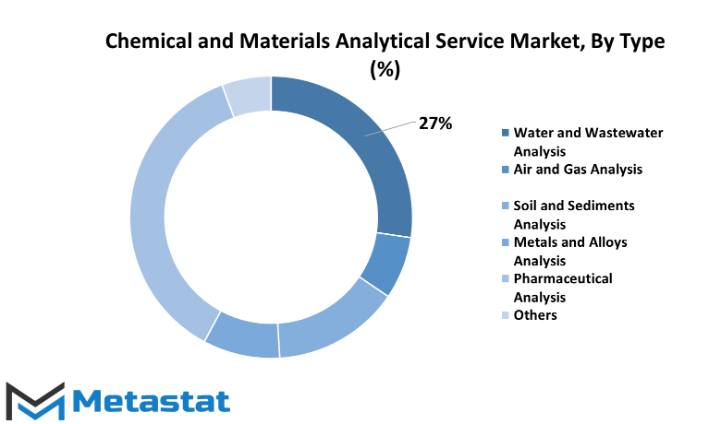
By Application
The global chemical and materials analytical service market is an essential service that fulfills the needs of different sectors. It is instrumental in offering the necessary inputs and data that are a must for the process of decision-making and quality control. One of the most notable features of this market is the classification by application, where three main categories are distinguished: Industrial, Business, and Scientific Research.
The Industrial segment, which has developed into a major player, is essentially a service that attends the manufacturing and industrial sectors. By using professional analytical services businesses in this field can greatly improve and also check if their products are in line with the current regulations in the market. It covers diverse applications that have ranged from the testing of the raw material and composition to the inspection of the product for the adherence of the safety and quality standards.
The Business fraction represents a mix of corporation types. This segment consists of companies that provide analytical services related to stakeholders who want to facilitate processes, reduce and actively manage risks associated with operational processes, and the operating procedures of organizations in general. Business clients are most likely to hire analytical services for market research, competition analysis, and operational improvements. The need for data and decision-based management practices has also driven positive growth in the Business segment.
Scientific Research is a sector that has a high demand and market potential for analytical services spanning the different scientific research disciplines of chemistry, biology, and environmental sciences. Scientific researchers often rely on analytical services to obtain their data, the materials, or the substances associated with their experiments, and studies. This market segment provides not only access to goods and/or services necessary for a range of scientific research but also the expertise to develop and change concepts and deliver new designs across a variety of scientific research disciplines.
The segmentation of the global chemical and materials analytical service market by application highlights the diversity of needs across the industries that the market serves. The Industrial segment can be viewed as the engine for quality and compliance in production processes, Business segment could be seen as the brain to execute decisions using data, and the Scientific Research segment is the heart for revolutionary discoveries. Together, all three segments that are responsible for elements of the market, indicate that the market is a significant vehicle for advancing and maintaining standards across the sectors.
By Air and Gas Analysis
The global chemical and materials analytical service market consist of a diverse and evolving industry that satisfies a broad range of industries and their needs. This market encompasses a wide variety of analytical services that essentially provide research and development, and quality control services across numerous applications, including chemicals and materials, etc. One major driver in such an industry is stringent applications concerning air and gas analysis.
Air and gas analysis consistently forms a critical component of the industrial processes in multiple sectors and enables accurate data for the purposes of safety, quality control, and compliance. The segment expands further to specific gas analysis. For example, Hydrogen, Ammonia, and CO2 are the most important components among other gases.
In 2025, the hydrogen segment in the market reached a value of 346.6 USD Million. The analytical service industry has a clear inferred need for analysis in safety and quality controls. The demand for hydrogen as an analytical service is driven from the energy, metal and electronic industries in particular.
Ammonia is one of the most significant gases, and the ammonia market is expected to reach $279.0 million by 2025. Ammonia is a major feedstock for the global food supply and is also widely used in cooling applications. Thus, analysis is warranted for products' quality and safety. The context of the analytical services has changed from the food/beverage industry to the agriculture or chemical industry, but this in no way changes the validity of the services.
The CO2 segment is expected to increase to a value of $442.3 million by 2025 and it is possible that the CO2 segment could be larger. Carbon dioxide is a potential driver of climate change and is a raw material for multiple industries. In order to monitor environmental quality and to protect and comply with regulations, CO2 must be scrutinized closely. Analytical services would find a number of valuable contexts for analysis, such as the environmental industry, medical/health industry, and beverage industries.
Additionally, the category of “Others” in the air and gas analysis section describes an assortment of gases and compounds, which have specific applications and associated analyses. This diverse grouping serves as an indicator of the complexity and diversity that exists within the chemical and materials analytical services market. Corporations that require dependable analytical data for safety, quality, and compliance have varying needs, and this is the fundamental reason for the specific value and need of services associated with gases such as Hydrogen, Ammonia, CO2, etc. The market is therefore well positioned to continue growth and transition to meet the increasingly changing needs of industry.
|
Forecast Period |
2025-2032 |
|
Market Size in 2025 |
$25,262.9 million |
|
Market Size by 2032 |
$42,400.4 Million |
|
Growth Rate from 2025 to 2032 |
7.8% |
|
Base Year |
2024 |
|
Regions Covered |
North America, Europe, Asia-Pacific Green, South America, Middle East & Africa |
REGIONAL ANALYSIS
Geography is the primary determining factor in the global chemical and materials analytical service market. The market is composed of different regions, as each has its own distinct characteristics and demands. In this situation, the global market for Chemical and Materials Analytical Services is unique from any other market, being a conglomeration of multiple markets based on their geographical delineation; it has North America and Europe as the two primary regions which affect this market significantly.
Due to its rich and diverse industrial base, North America is a key player in the global chemical and materials analytical service market. This region consists of the US, Canada, and Mexico, all of which have their own separate Industrial bases and analytical service's needs. The US has a huge and diverse industrial base including manufacturing, health care, technology, and energy. As a result, nearly all of these industries require some type of analytical services to address their testing needs, such as, sometimes composition of materials testing, environmental testing, etc. Canada and Mexico also have their own distinct industrial bases and regulatory needs which could create for the industry of analytical services even additional unique opportunities.
In contrast, the European continent displays a more complicated geography of nations, each nation has its unique economic and industrial characteristics. The European chemical and materials analytical service market consists of EU member countries and some additional countries as well, such as the United Kingdom and Switzerland. Europe has a significant industrial base that includes the automotive, chemicals, pharmaceuticals, and food industries to name a few. Europe's focus on sustainability and environmental protection is a catalyst for the demand for analysis from compliance, product quality, to safety.
Both North America and Europe require similar high analytical services, but their focus and needs are dramatically different. Innovation and technology may play a larger role in North America, than sustainability and compliance in Europe.
It is essential for service providers and businesses wanting to succeed in the evolving context of the Chemical and Materials Analytical Service industry to appreciate the geographical nuances. In fact, tailoring services to the unique needs of North America and Europe is both a strategic imperative and requirement to succeed in these leading markets.
COMPETITIVE PLAYERS
The global chemical and materials analytical service market encompasses the varying instances where price values for the same item are very important. The markets are worlds where a vast array of industries rely on services that offer deep analyses of Chemicals and Materials for their quality, safety, and with respect to regulations.
The leading companies in the global chemical and materials analytical service market are Eurofins Scientific and Intertek. These companies are the market leaders and suppliers of services that are diverse and multifaceted in nature across all sectors and industries, among them pharmaceuticals, agriculture, and manufacturing. Eurofins Scientific is recognized globally as the industry leader when it comes to analytical services with the ability to provide a full range of services related to chemical analysis and quality assurance, across a range of different testing. Their scalable capabilities and expertise fit across several different industrial sectors and make the organization potentially the most desirable option for organizations seeking a solid and established laboratory service that is accurate and timely.
Intertek is an important player in the Chemical and Materials Analytical Service competitive landscape. They specialize in ensuring that materials and products are safe and high quality. One of the services they offer is chemical analysis testing, performance testing, and regulatory compliance. Their services assist various industries to satisfy rigorous quality and safety standards.
Industries have to rely on both Eurofins Scientific and Intertek to offer them a complete suite of analytical services, which is imperative in today s industrial environment where quality is key. These companies empower other businesses in confident that the raw materials and end-products are in agreement with the highest quality safety and efficiency. In an era where precision and compliance are non-negotiable, these key players in the Chemical and Materials Analytical Service industry play crucial roles in facilitating smooth operations across various sectors.
Chemical and Materials Analytical Service Market Key Segments:
By Type
- Water and Wastewater Analysis
- Air and Gas Analysis
- Soil and Sediments Analysis
- Metals and Alloys Analysis
- Pharmaceutical Analysis
- Others
By Application
- Industrial
- Business
- Scientific Research
By Air and Gas Analysis
- Hydrogen
- Ammonia
- CO2
- Others
Key Global Chemical and Materials Analytical Service Industry Players
- Eurofins Scientific
- Intertek
- SGS
- Element Materials Technology
- ALS Global
- UL LLC
- ITA Labs
- IMR Test Labs
- Pacific Lab
- Southwest Research Institute
- Case Chemicals
- NDE Analytical
- SolvChem
- Applied Technical Services
- TAMI (IMI)
- FORCE Technology
- TÜV SÜD
- James Hutton
- Berkeley Analytical
- Sumika Chemical Analysis Service
- STC Group
- Laboratory Testing
WHAT REPORT PROVIDES
- Full in-depth analysis of the parent Industry
- Important changes in market and its dynamics
- Segmentation details of the market
- Former, on-going, and projected market analysis in terms of volume and value
- Assessment of niche industry developments
- Market share analysis
- Key strategies of major players
- Emerging segments and regional growth potential



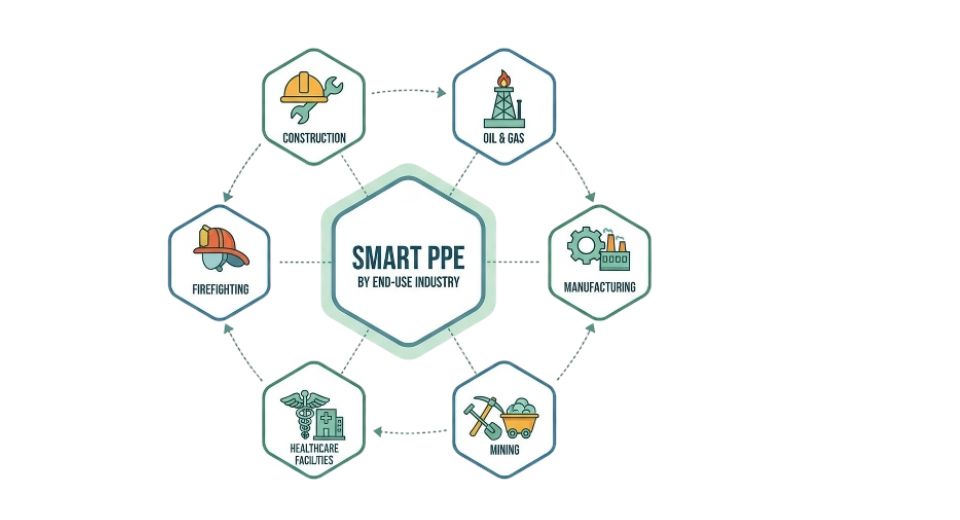
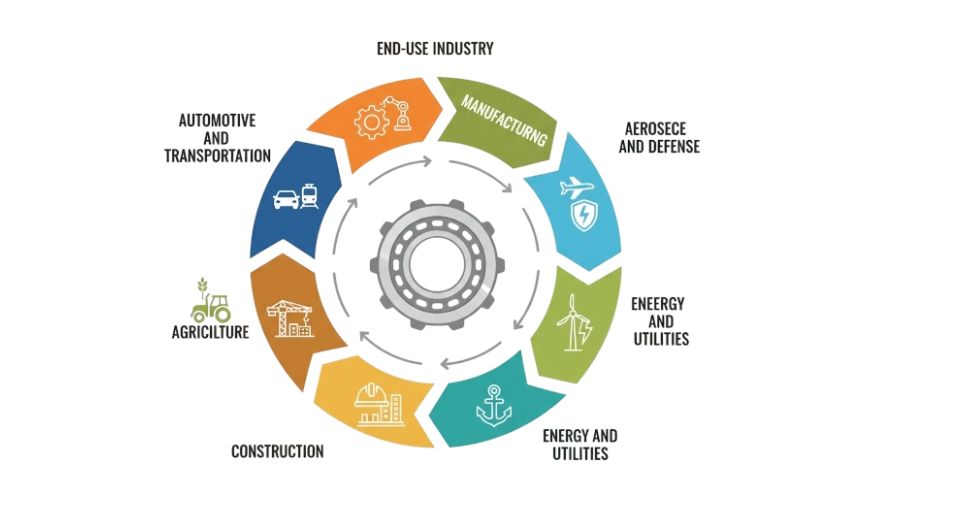
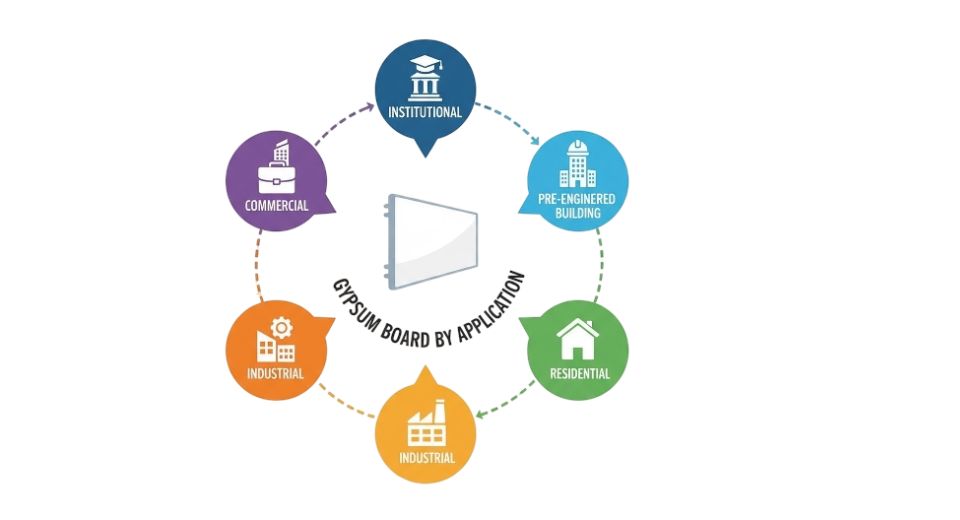
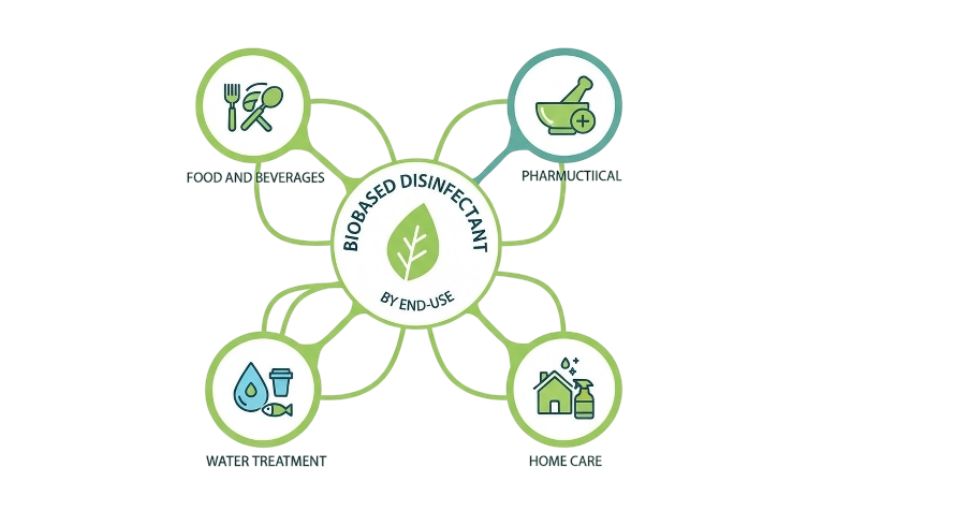

 US: +1 3023308252
US: +1 3023308252






